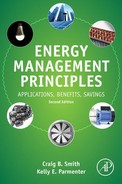List of Tables
| Table 1.1 | Energy management terminology | 7 |
| Table 1.2 | Basic conversion factors | 11 |
| Table 2.1 | World primary energy use, by source, 2013 | 16 |
| Table 2.2 | Approximate world electricity production | 17 |
| Table 2.3 | Energy use by sector, 2011 (109 GJ/year) | 18 |
| Table 2.4 | Estimated proven reserves of fossil fuels | 20 |
| Table 2.5 | Examples of policies and programs for energy management | 25 |
| Table 2.6 | Nonenergy benefits of energy management programs | 30 |
| Table 3.1 | General principles of energy management | 38 |
| Table 4.1 | Planning an energy management program | 46 |
| Table 6.1 | Principles of site and building audits | 72 |
| Table 6.2 | Site audit energy management opportunity checklist | 80 |
| Table 6.3 | Examples of equipment for detailed audit measurements | 83 |
| Table 6.4 | Building audit energy management opportunities | 88 |
| Table 7.1A | Nominal full load efficiencies: NEMA premium high efficiency electric motors | 97 |
| Table 7.1B | European Union IE3 premium motor efficiencies (3-phase cage induction motors) | 97 |
| Table 7.2 | First-law and second-law efficiencies for single-source, single output-devices | 102 |
| Table 7.3 | Causes of inefficiency | 105 |
| Table 7.4 | The aggregate impact of inefficiency | 109 |
| Table 7.5 | Steel mill data for a summer day daily load curve | 118 |
| Table 8.1 | Principles for energy management in HVAC systems | 127 |
| Table 8.2 | Examples of rate of heat produced by humans (Varies by person) | 132 |
| Table 9.1 | Energy management opportunities and lighting systems | 199 |
| Table 9.2 | Calculation of maintenance labor savings for sodium lighting example (US$) | 202 |
| Table 11.1 | Examples of principles for process energy management | 232 |
| Table 11.2 | Properties of fuel materials | 241 |
| Table 11.3 | Combustion efficiency for natural gas | 243 |
| Table 11.4 | EMOs with process heat | 252 |
| Table 11.5 | EMOs with electric motors | 264 |
| Table 11.6 | EMOs in electrolysis | 270 |
| Table 11.7 | Power requirements and compressor air inlet temperatures | 273 |
| Table 12.1 | Energy management principles for integrated building systems | 285 |
| Table 12.2 | Typical thermal conductivity values, k | 297 |
| Table 12.3 | Convective heat transfer coefficient, hc | 297 |
| Table 12.4 | Heat losses through glazing systems, in W/m2·K | 299 |
| Table 12.5 | Heat loss calculation for a Southern California residence, W/m2·K | 299 |
| Table 12.6 | Energy management opportunities in the building envelope | 303 |
| Table 12.7 | Benefit of improved insulation | 304 |
| Table 12.8 | Heat loss comparison for three building designs (heat loss in Watts) | 306 |
| Table 12.9 | Average energy end use per U.S. household (2009) | 310 |
| Table 12.10 | Basic energy storage (heat/cool) system input parameters | 319 |
| Table 12.11 | Six principles of sustainable design | 327 |
| Table 13.1 | Checklist of data for energy management economic studies | 333 |
| Table 13.2 | Life-cycle costing example (in US$) | 336 |
| Table 13.3 | Formulae and nomenclature for economic analyses | 340 |
| Table 13.4 | Benefit/cost example | 341 |
| Table 13.5 | Payback period example | 342 |
| Table 13.6 | Present worth analysis | 344 |
| Table 13.7 | Equivalent annual cost analysis | 346 |
| Table 13.8 | Capitalized cost analysis | 347 |
| Table 13.9 | IRR analysis | 348 |
| Table 13.10 | Nonuniform annual cost example (US$) | 349 |
| Table 13.11 | Comparison of methods | 353 |
| Table 13.12 | Summary of calculations for heat recovery example (in US$) | 356 |
| Table 14.1 | Principles for implementing and assessing an energy management program | 360 |
| Table 14.2 | Costs and energy savings for XYZ company’s energy management opportunities | 363 |
| Table 14.3 | Ranking of XYZ company’s potential projects | 363 |
| Table 14.4 | Codes and regulations to consider for energy projects | 363 |
| Table 14.5 | Motivating personnel for energy management | 367 |
| Table 14.6 | Information to include in an M&V plan | 370 |
| Table 14.7 | Cost avoidance report for XYZ company’s lighting controls project | 379 |
| Table 14.8 | Develop continuing energy management efforts | 381 |
| Table 14.9 | Planning new facilities: energy considerations | 382 |
..................Content has been hidden....................
You can't read the all page of ebook, please click here login for view all page.
